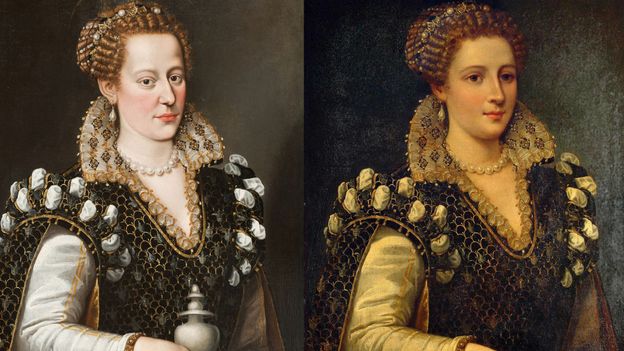(Picture credit score: Carnegie Artwork Museum)
Restorers are uncovering ‘forgotten faces’ that had been later retouched, with painters centuries later including plump lips, sculpted noses and tapered chins, writes Kelly Grovier.
S
One thing occurs to our faces. They disappear. Instantly, AI magnificence filters on the cameras of our smartphones, on Instagram and TikTok permit us to clean out each irregularity and asymmetry that defines and distinguishes us – the quirky particulars that make you, you. We’re exterminating ourselves.
Extra like this:
– The portray that challenged sexual norms
– The masterpiece that grew to become a meme
– The tragedy of artwork’s best supermodel
It’s after all tempting to imagine that know-how is accountable, that we’re fixing our faces as a result of for the primary time in historical past we are able to. However faking magnificence has a protracted historical past. A glimpse of that custom emerged in current days when it was revealed that conservators for English Heritage, whereas cleansing a Seventeenth-century portrait of the great-granddaughter of one in all Queen Elizabeth I’s closest pals, William Cecil, Lord Burghley, found that Op Diana Cecil’s likeness had a form of magnificence filter utilized within the years after it was accomplished.
Portrait of Diana Cecil (1634) by Cornelius Johnson earlier than restoration (Credit score: English Heritage)
Although thought-about a stunner in her personal time, Cecil’s straight hairline and slender lips – as initially captured in 1634 by outstanding English portraitist Cornelius Johnson when she was 31 years previous – had been not as much as par when restorers began engaged on her. someday earlier than the tip of the nineteenth century. Aggressive overpainting of the portrait, which matches on show at London’s Kenwood Home on November 30, got here to mild when English Heritage eliminated a layer of previous varnish. The retouch had plumped Cecil’s lips and pulled her curly bangs right down to cowl extra of her brow, bringing her look and status as a legendary presence according to altering attitudes to magnificence.
Portrait of Diana Cecil (1634) by Cornelius Johnson after restoration (Credit score: English Heritage)
The faking of Cecil’s face was not the primary time a sitter’s look had been imitated – prioritizing modern notions of attractiveness over physiognomy. That distinction in all probability belongs to a retouched likeness from a century earlier: the portrait of a tragic member of the highly effective Medici household, Isabella de’ Medici (daughter of Cosimo I de’ Medici), who was allegedly murdered after a scandalous affair. together with her husband’s cousin, the Italian nobleman Paolo Giordano Orsini.
The true traces of Isabella’s face had been so radically erased that the Carnegie Museum of Artwork in Pittsburgh, which owns the work, did not even know they’d a likeness of her in its assortment. It was solely when the establishment sought to verify its suspicions in 2014 {that a} portrait it owned of one other member of the well-known Medici household, Eleanor of Toledo (reportedly painted by the celebrated Italian mannerist Bronzino), was faux that Isabella’s forgotten face was made public. lurking beneath the varnish was saved from oblivion.
Portrait of Isabella de’ Medici (1574), attributed to Alessandro Allori – earlier than (left) and after (proper) restoration (Credit score: Carnegie Museum of Artwork)
One thing concerning the candy grin, flawless complexion, sculpted nostril and completely tapered chin depicted within the work because it initially appeared within the museum in 1978 simply wasn’t proper. However earlier than the portray was faraway from the CMA’s assortment, it was subjected to radiological evaluation. What stared again within the X-rays was another person completely: a way more convincing face of an older, extra drained girl with pointy pores and skin, a barely hooked nostril, circles underneath her eyes, a double chin and hammy fingers. In different phrases: an actual individual.
Along with ‘fixing’ her look, the overpainting (thought to have taken place someday within the nineteenth century) eliminated a number of symbols meant to equate Isabella with Mary Magdalene, a penitent determine signifying regret: an alabaster jar with ointment, inserted after Isabella’s look. demise, and a fading halo hovering above her head. Two years after her portrait was painted in 1574 by an artist from the circle of the Florentine grasp Alessandro Allori, Isabella’s life all of a sudden ended underneath suspicious circumstances on the age of 33 – as emphatically erased as her picture was doomed to be.
Portrait of Derich Born (1533) by Hans Holbein the Youthful (Credit score: Royal Assortment Belief / His Majesty King Charles III)
It isn’t simply girls’s faces which can be pressured to lie. Neither is it the case that future generations are solely chargeable for filtering out unflattering traits. A technology earlier than Isabella’s poignant, bossy look was commemorated within the 1570s, celebrated German-Swiss painter Hans Holbein the Youthful discovered himself flicking by means of magnificence filters on his personal easel as he painted a portrait of Derich Born – a younger man with a child face . service provider in Steelyard in London, the English base of the highly effective Hanseatic League.
A current restoration of the 1533 portrait on the J Paul Getty Museum in California has uncovered proof that Holbein appeared dissatisfied with the swollen cheeks and delicate jawline of the face when he initially transcribed it, returning repeatedly to his portrait, with minor however consequential changes. In the event you examine the ultimate outcomes of Holbein’s tinkering with an Insta-fabulous, Insta-cool.
In the event you preferred this story, join the publication of The Important Listing – a hand-picked collection of options, movies and unmissable information, delivered to your inbox each Friday.
;

